INTRODUCTION
For thousands of years, mariner's communications consisted of simply
two types - sound and visual. Bells, whistles and horns were used for sound
signalling, while visual signalling employed flags, lights and later on,
semaphore signalling. Naturally enough, this form of communication required
the development of codes in order for the sound or visual signalling to
have any meaning. It soon became evident that even a single flag in a prominent
position could serve to transmit a clear and comprehensive message.
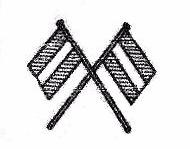 |
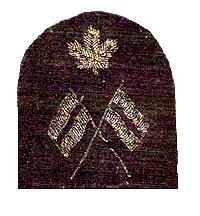 |
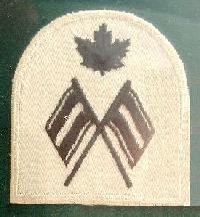 |
| Ordinary Signalman and Signal Boy badge in 1937. (Via Spud Roscoe) | Signalman badge from 1955 to 1968 (Via Spud Roscoe) | The uniform for junior ranks, up to P2, was square rig. This was the badge worn on that uniform. |
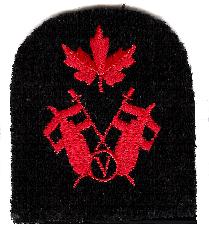 |
| Communicator (V)isual badge 1948-1955 |
During WWII, anyone practicing Visual Signalling was known as a Signalman. By 1950 there was a CR, CS, CV, CC, rating all with the same badge with the exception of the letter in the circle. Shortly after that, the navy combined the CV and CR to CM and made them one and the same. The CM ratings did a watch in the radio room and then did a watch on the bridge as a Signalman. This only lasted a couple of years and it was just too much for one trade. They went back to CR and CV. CV was Communicator Visual, the Signalman. The CC disappeared sometime around 1953. Just before 1960 the trade name changed. CV became Signalman SG with crossed flags. When the Armed Forces unified in 1968, the trade was renamed to SIGSEA and in 2007 is known as NAVCOM.
This article, titled "Communications Branch Split Into Visual, Radio Sections " from the April 1951 edition of Crowsnest Magazine, details the changes in 1950.
"Shortly after WWII it was considered that the requirement for visual signalling had been greatly reduced by the increased use of radio and the fact that the Electrical branch had assumed the maintenance of radio equipment. As a result, the rates of Signalman and Telegraphist were combined to form the Communicator trade. Since Visual signalling has been regaining its former importance, approval was recently given to the splitting of the Communications branch into Visual (CV) and Radio (CR) sections.Generally speaking, Visual Signalling consists of: Flag hoist, Semaphore, Directional and non-directional flashing light and pyrotechnics. Naval Signalman are usually well versed in maritime weather warning displays from shore based signal towers and coastal, small craft, marinas. Additionally, the "International Rules of the Road" for all vessels on the high seas utilize a number of visual shapes (ie colored canvas balls) and colored light displays on the vessel's mast(s) to indicate "breakdown", divers in the water, etc. Lighthouses and lightships can be identified in daylight by their unique paint schemes and in darkness by the light sequences of their beacons.In peacetime, all visual and cryptographic duties will be carried out by the Visual men while radio duties will, of course, be the responsibility of the Radio man. In event of hostilities, the old Coder rate of the Second World War would be re-instituted, as well. New entries for the Communications Branch will be entered in the Navy as OSCMS and at the end of new entry training in Cornwallis will proceed to the Communication School, where they will undergo a common basic professional course, upon completion of which selection and volunteering for specific sections will take. place. Specialized training will then continue in either the Visual or Radio section. Communicators were allowed until March 15, 1951, to select the section they wished to join and commanding officers have forwarded these preferences to Headquarters in order that separate rosters for Visual and Radio, Communicators may be compiled.
It is hoped, and is probable that there will be an even split between branches. However, if there is a landslide toward either the Radio or Visual section, certain men will have to be allocated arbitrarily to sections in order to maintain a reasonable balance. Men allocated in this manner may subsequently request to transfer within the branch. No changes have been made with respect to trade grouping and substantive structure, except that an oral examination will be required after April 1, 1951, for advancement to Leading Seaman. This examination will be based on the duties performed by the rating during his preceding six months of service and corresponds to the Old Trained Operator examination. It is emphasized that no man will lose roster points or be placed in an inferior roster position to that which he now holds."
Both Directional and Non-Directional flashing light systems utilize International Morse Code. Directional flashing lights are equipped with shutter assemblies operated by handles. Non-Directional flashing lights on the yardarms of vessels utilize a telegraph key. Directional and Non-Directional signal light systems can transmit either "white" or "black" signals. The "white" signals during daylight are a brilliant bare lights. At night, (to reduce the brilliance and glare), the directional lights are fitted with a "reducers" or coloured glass filter hoods. Black (infrared "Nancy") signals are transmitted both directionally and non-directionally, using a black covering called a pot, a globe or hood fitted over a regular white bulb. Black light signals are only used during hours of darkness and an infrared viewer or "spotting scope" must be used to see the signal. On directional signal lights or projectors, there is usually a bracket to hold the Nancy "viewer" or "scope" on the barrel of the light so the Visual Signalman can keep the signal light trained and elevated on the target ship while his own ship is rolling or pitching. Both white and black visual light signals can be either Plain language or encrypted. Signals were decrypted in the ship's code room just as wireless radio signals had to be decrypted. Visual Signalmen also used the "Q" and "Z" operating signals just like wireless radio operators.
Sound Signaling also includes the use of a naval vessel's bell, siren, horn or gun firing. Naval signalman usually assist the Officer-of-the-Deck in deciphering the meaning of any sounds emitted by a vessel that is backing away from a pier or wharf or has intentions of either passing on-coming vessels either to port or starboard. In order to prevent collisions, bell signals are sometimes used during reduced visibility (fog) for the benefit and safety of vessels that are not fitted with radar.
WWII ERA
THE WRENS ROLE IN VISUAL SIGNALLING (VS)
Many personnel from the Women's Royal Canadian Naval Service (abbreviated as WRCNS, pronounced as WRENS) served in the Visual Signalling trade at shore establishments during WWII.
The organization was established on July 31 1942 in order to recruit women to replace men who were leaving for sea duty. Capt. Eustace Brock became the Director and Lt Cdr Isabel Macneill, OBE, became the C.O. of the WRCNS training establishment, namely HMCS Conestoga which was commissioned on June 1, 1943 in Galt Ontario. She was the first woman in the British Commonwealth to hold an independent naval command. There were 22 different job categories open to women, depending on their background and experience. They filled many jobs in every naval base in Canada. Just one year after the WRCNS was established, they were already earning high praise for their efforts. The WRCNS motto was: To free a man for service afloat.
During basic training at HMCS Conestoga Ontario, WRENS learned naval rules and regulations - how to obey orders, how to march, and how to salute. After a month, they were posted to other facilities for training in the trade to which they were assigned. For those WRENS designated as Visual Signalers, the next stop was the Communications School at St. Hyacinthe, Quebec or "St. Hy" for short.
VS Wrens replaced VS Sailors (bound for sea duty) at signal stations from St. John's, Newfoundland to Prince Rupert, BC . During the war, visual communication from ship to ship and ship to shore was necessary because radio silence had to be maintained to prevent enemy submarines in and around Canadian waters and at sea from intercepting vital information such as the movement of convoys.
Elsa Lessard, who served at HMCS Coverdale during WWII, reminisces about St. Hy. "In September 1943, I finally got the six month telegraphist course at St. Hyacinthe, near Montreal. We were housed in really long sheds. A row of 15 or so double-decker bunks lined each wall and down the centre aisle was a series of small pot-bellied stoves, which had to be stoked by us. On fire-duty night you crept around with a flashlight tending each stove in each block (as quietly as possible or else!) and ended the watch with hot kye in the galley. The hardest part of the watch was to wake the Wren who was to replace you and get her on her feet without waking the whole block."
Beatrix Shreiber-Geary, a former WREN VS, describes her posting after St. Hy. “We, "the gang of six", were drafted to HMCS Stadacona in Halifax where we started duty watches in the signal towers on top of the Halifax Post Office and at Jetty Three in the Dockyard. Now we could really test our ability to send and receive. Most of the messages were coded and top secret. It was against regulations to signal personal messages, but when the hours were long and there was no activity, we did talk on the light once in a while. At least one VS WREN met her future husband on that light.
At night the ships at anchor in the harbour could only show one small light. From our lofty signal tower it was like a sea of fireflies reflecting in the water. In the morning the harbour was empty; the convoy had slipped silently in the darkness of night. We often wondered how many escaped the German torpedoes while crossing the Atlantic”.
Each morning everyone was awakened by a loud "Wakey, Wakey”. The PA speaker was eventually stuffed with sanitary pads to muffle the sound. Before breakfast , there were daily route marches along the Yamaska River. A naval band led the way with bell-bottomed WRENS following. It was a healthy and invigorating way to start the day.
WRENS practiced signalling by semaphore from the flag decks on rooftops around the parade square. Many hours were spent every day sending and receiving Morse on the signal lamps, until they were thinking in Morse. Semaphore was taught to musical rhythm, often on the parade square to the accompaniment of the St. Hy band. From the flag decks they also learned how to hoist signals using flags and pendants. The Fleet Signals Book had to memorized along with the different flag combinations and their meanings. To even qualify for Visual Signalling, all recruits had to have 20/20 vision without the aid of eyeglasses.
St. Hy had one of the best bands for marching and dancing. At divisions it was difficult to stand at attention for inspection when the band was playing a favourite tune. Dances in the Drill Hall were always fun. The WRENS were outnumbered by sailors four to one so each one typically danced with several different men. It was great for a girl's morale.
On graduation, the WRENS became full-fledged Visual Signallers (VS) , or "Bunting Tossers", as they were sometimes called. They could now proudly wear the "Crossed Flags" on their sleeves.
Because the Visual Signalling branch was such a colourful one, it was selected to publicize the WRCNS for recruitment purposes. A number of photos, taken from St. Hy rooftops during training of WRENS signalling to other WRENS, appeared in major newspapers across Canada.
**********
James McAlister relates his WWII experiences. "I was on five month course at the St. Hyacinthe Communications School in Quebec. Some of the huts had small flag decks. These were equipped with a Signal Projector (SP) for practice use. There were also two masts, one of about 75 feet high for practicing flag hoists. If you lost a halyard, you had to climb up and out on the yardarm to secure it so you made sure that you had a secure connection if possible. There were two types of flag hoists which had to be learned, - Naval and International. In addition to alpha and numeral flags, there were also 26 special identity flags as well as 24 pendants in the Naval system.
The flag decks were used for training in Morse with the lights and also a single flag system which was called Wig-Wag. In addition to alpha and numeric, there were also punctuation, procedure signs and other miscellaneous signs to be learned. We also had to learn semaphore. The only time that I used it was when a Yank ship gave us instructions as we entered New York Harbour and instead of bringing the unused flag to the rest position would fling it out of sight over his shoulder.
It was necessary to obtain a certain proficiency in all aspects of signalling to graduate from the course. Failure to achieve certain milestones would almost guarantee rejection. Although we were never at action stations, I understand that Sigs not on duty may be involved in munitions handling, etc. As I mentioned, we were seldom involved in painting ship and other such duties, as the Confidential Books had to be kept up to date, etc. and visits to the shore signal school for updating.
The Manual of Seamanship 1937, as reprinted for Canadian use in January of 1942, shows Visual Signalman and Wireless Telegraphist as two entirely separate entities and as far as I know they remained so for the remainder of the war years. How I came to have this book is another matter. When I first joined they sent us to run the sea cadet camps on Georgian Bay. A transfer to Comm came through while I was there but it was not acted upon when we returned to York for Basic Training and then not until I had spent 10 weeks training as a Seaman at Cornwallis. Such was life in the wartime Navy.
VS (Visual Signalling) Ratings were the poor souls that stood on the open bridge alongside the signal projectors and acted as lookouts when not using them to send a message. On smaller ships we often had to go back to the old style searchlight, which in some cases, had no return spring on the operating lever for the shutters
WWII naval signalmen who served on the Convoy Commodore's ship would also have had to know convoy signals and I imagine their relationship with the Commodore would be like a Yeoman to the Captain aboard a naval ship during the war. I remember a visit to the Naval College in Greenwich, England a few years ago. At the entrance to the chapel was a memorial to Convoy Commodores and Convoy Signalmen who had paid the supreme sacrifice. The memorial listed all their names".
Don Wagner, Former Signalman Second Class Petty Officer (SM2), (USN 1956-59) adds to this. " The single flag visual signal system that James referred to was also known in the United States Navy as "Wig-Wag". The flag was held above the operator's head - one side was the "Dits", the other side was the "Dahs" (Morse Code with one flag). The United States Army also used this method, as well as the Navy around the turn of the 20th century and before the birth of wireless.
Although I spent the majority of my career as a Cryptologic Technician, being a Signalman was the most enjoyable experience. I was on the "bridge" where decisions were being made and things were happening!"
Spud Roscoe adds. " Anything pertaining to the Royal Canadian Navy from 1910 until 1949 was identical to the Royal Navy. Branches, trades, badges and so on. During World War I the wireless operators were Warrant Officer Telegraphists and were graduates of the civilian radio schools. As far as I know these telegraphists held Certificates of Proficiency in Radio from Britain, Canada and so on. These licenses were created and based on regulations issued by the International Telecommunication Union. During WWII, the Signalman wore crossed flags while the Telegraphist had the wings of mercury."
Bill Loucks, VE3AR, served with the RCN during WWII. He explains the relationship between the VHF radio set and visual signalling. "For security reasons, we usually used VS to communicate with other ships by Morse code, however this was impossible in fog or bad weather. Along came the TBS set to fill the void. This was an AM transmitter/receiver operating in the range of 60 to 80 MHz and running about 70 watts. TBS acquired the moniker "Talk Between Ships" by those who used it. It was installed in the Chart Room just off the bridge so that personnel on the bridge could use it without the need for a wireless operator. Being VHF, it was considered more secure than HF which could be detected and DF'ed over far greater distances. However, it still was less secure than visual signalling so it was used with discretion. In those days there still was a debate going on between the merits of AM vs FM as the preferred method of modulation for VHF. AM was chosen for the TBS but after the war AM would be abandoned in favour of FM".
TERMS RELATED TO VISUAL SIGNALLING
Douglas Moore of the Cornwallis Museum provides these terms used in Visual Signalling and some responsibilities of a Signalman from the 60's era.
Manoeuver - these were conducted using signals from ACP 175.
e.g
Formation 1 - ships are to form column or
Formation 3 - ships are to form line abreast.
Some other maneuvers were:
Form Golf Div - Divisions are to form on line of bearing of 315 from
their guide
Form 315 - ships are to form on line of bearing from their guide
Ship's Message Centre - Signalman looked after the Message Centre. Their job was to distribute all incoming and out going messages and file the same depending on the subject of the messages. They also looked after the cryptographic messages within the message centre.
Tactical Circuits - Signalman manned the tactical circuits on the bridge and in the Ops room. All signals concerning maneuvers, etc were passed on the tactical circuit.
Tactical Screens - Tactical screens were formations were ships, normally frigates and destroyers, were formed in a circle on different bearings and the same distance from carriers, supply ships, submarines, etc. In other words, they formed the outer shell around the bigger ships.
Maritime Command - Ssignalman could be posted to Maritime Command to do either Message Centre work (explained above) or tower work which entailed keeping watch over the harbour. Signals were transmitted from the tower by flag hoist. semaphore or Morse code using a light.
Keith Kennedy adds: "Joint Ops Codes (JOC) were used by radiomen sending CW over the radio, and by signalmen using CW and signal projectors I think the JOC was either a 3 or 4 letter code with each group representing a whole phrase and was considered low grade with only 6 or 8 hour security time. It was seemingly a lot of material to store in the CB vault with little use. I can't recall it ever being employed except during exercises in order to maintain some level of proficiency".
BUNTING TOSSER (BUNTS)
In the Royal Navy those sailors in the signals branch whose duties include the care and hoisting of signal flags, flags of command and ensigns etc were called Bunting Tossers or Bunts for short.
Bunting is the material that flags are made from. Visual Signalmen had the additional duties of repairing and making from scratch, new flags to specifications in a publication. This not only included signal flags but the national flags and ensigns of foreign nations. Many a signalmen became proficient with a sewing machine as a result of this responsibility.
This term Bunting Tosser also found its way into RCN useage. A Petty Officer in the branch was known as a "Yeoman" and a CPO as "Chief Yeoman" - terms that are now extinct in the visual signalling trade. It was the usual practice for the Senior V/S rating to be on the bridge when the Captain was present.
In the USN, Signalmen were called "Skivvy Wavers".
RESPONSIBILITIES OF A NAVAL COMMUNICATOR TODAY
In 1984, under the Maritime Occupational Restructure Program (MORP), the name SIGSEA became NAV SIG and in 1998 with the amalgamation of the NRA DOP and NAV SIG trades, it became NAV COMM.
The Military Occupation Code (MOC) varied over the years. Some examples are: SIG SEA 261, NAV SIG 262, NAV COMM 277. Then, in the mid 2000's, the MOC acronym became MOSID (Military Occupational Structure IDentification). NAVCOMM is now MOSID 00299.
An excerpt from the web page of HMCS Edmonton define the duties of a Naval Communicator circa 2006:
* Naval Communicators are responsible for the operation of communications information systems and for the implementation of communication procedures and instructions. Naval Communicators (NAV COMMs) are also responsible for the collection, correlation and dissemination of operational and tactical information. NAV COMMs encode, decode and interpret operations, tactical and manoeuvring signals, as well as type, log, and advise on matters related to communications, communication security (COMSEC), ceremonial and fleet manoeuvring.
* Operate systems which include: shipboard radio/satellite equipment; message processing via local area network; and cryptographic equipment.
* Communicate by: intership, ship/shore radio teletype; ship/shore satellite, voice and radio teletype; INMARSAT voice, facsimile and email; tactical, international and administrative voice radio; flashing light (Morse code); flag signaling; and semaphore.
* Tactical Signaling: advise command on tactical signaling and ship manoeuvring; and encode/decode and disseminate tactical and manoeuvring signals Perform and advise on shipboard flag ceremonial procedures.
In summary:
1. Maintain watch on VHF and other tactical radio circuits.
2. Maintain visual watch for flashing light, semaphore and flaghoist.
3. Send signals via radio, flashing light, semaphore and flaghoist.
4. Encoding/Decoding of tactical signal in all media
5. Hailing ships on VHF to ascertain identity and intentions.
6. In charge of maintaining a formation picture. Knowing at all times,
the identity of ships in a task group and having the ability to move them
into various formations based on mission requirements.
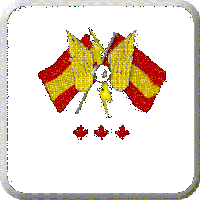 |
| The NAVCOM badge (2006). (Image courtesy RCN) |
CPO2 Derrick Shillington, HMCS Toronto Combat /Training Chief provides this snapshot of the trade in 2007:
"The principal visual duties of the NAV COMM trade remain much the same
as they did for the NAV SIG. however, the use of flashing light, semaphore
and flag hoist have diminished over the years as technology continues to
advance. With the MORP in 1984 , we lost the maintenance of our signal
lamps to the electricians and Teletype maintenance to Communication technicians.
Challenge
and Reply by visual means is no longer carried out. The use of Morse
Code to key infrared light to communicate between ships is no longer used.
Bridge communicators do the initial hails using VHF radio for Maritime
Interdiction Operations (MIO). Signalman no longer participate in the operations
room during naval gunfire support as our guns are no longer used to fire
ashore."
|
======= > NAV COMM
========= NAV SIG ========= SIGSEA ===== Signalman ====== Communicator Visual ======= Signalman --|----|----|----|----|----|----|----|----|----|----|----|----|----|----|----|----|----| 1940 45 50 55 60 65 70 75 80 85 90 95 00 05 10 15 20 2025 |
| This time line summarizes the various names that the visual signalling trade was called between 1937 and present day. |
TOOLS OF THE TRADE